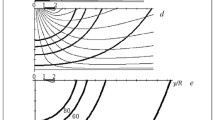We consider a method aimed at screening contaminants with the help of local exhaust ventilation whose important element is a local suction gun. We investigate the influence of the ratio of the geometric sizes of the suction gun and the circular hole and the ratio of the flow rates of intake and suction air on both the distance of suction entrapment and reduction of the dust flows in local closed-type suction guns. We also consider local suction guns in unbounded, semibounded, and bounded spaces.



Similar content being viewed by others
References
E. Gonzalez, F. Marzal, A. Minana, and M. Doval, “Influence of exhaust hood geometry on the capture efficiency of lateral exhaust and push-pull ventilation systems in surface treatment tanks,” Environ. Prog., 27(3), 405 – 411 (2008).
I. Kulmala, P. Hynynen, I. Welling, et al., “Local ventilation solution for large, warm emission sources,” Ann. Occup. Hyg., 51(1), 35 – 43 (2007).
M. J. Chern and W. Y. Cheng, “Numerical investigation of turbulent diffusion in push-pull and exhaust fume cupboards,” Ann. Occup. Hyg., 51(6), 517 – 531 (2007).
T. Iwasaki, Y. Fujishiron Y. Kubota, et al., “Some engineering countermeasures to reduce exposure to welding fumes and gases avoiding occurrence of blow holes in welded material,” Ind. Health, No. 43, 351 – 357 (2005).
X. Wen, D. B. Ingham, and B. Fletcher, “The numerical modeling of a two-dimensional local exhaust system associated with an inclined jet flow,” J. Eng. Math., No. 43, 367 – 384 (2002).
I. Kulmala, ”Experimental validation of potential and turbulent flow models for a two-dimensional jet enhanced exhaust hood,” AIHA J., No. 61, 183 – 191 (2000).
I. N. Logachev, K. I. Logachev, and O. A. Averkova, “Local exhaust ventilation,” in: Aerodynamic Processes and Calculations of Dust Emissions, CRC Press (2015).
G. R. Hunt and D. B. Ingham, “Long-range exhaustion — a mathematical model for the axisymmetric air flow of a local exhaust ventilation hood assisted by a turbulent radial jet,” Ann. Occup. Hyg., 40(2), 171 – 196 (1996).
C. J. Saunders and B. Fletcher, “Jet enhanced local exhaust ventilation,” Ann. Occup. Hyg., 37(1), 15 – 24 (1993).
Z. Cao, Y. Wang, H. Zhu, and M. Duan, “Study of the vortex principle for improving the efficiency of an exhaust ventilation system,” Energy Build., No. 142, 39 – 48 (2017).
L. V. Kuz’min, A. M. Popova, A. S. Gus’kov, and L. S. Dmitrieva, ”Vortex ventilation formed by four compact jets,” Vodosnabzh. Sanit. Tekh., No. 2, 20 – 22 (1991).
F. Penot and M. D. Pavlovich, “Experimental study of nonisothermal diverging swirling and non-swirling annular jets with central aspiration,” Int. J. Ventilation, 8(4), 347 – 357 (2010).
S. Y. Spotar and A. L. Sorokin, “Focusing of the flow capture for local exhaust ventilation systems,” Am. J. Appl. Sci., 7(6), 732 – 738 (2010).
V. G. Ivenskii, “Application of air vortices for the activation of open local exhausts,” in: Collect. Sci. Pap. “Heat Supply and Ventilation of Agricultural Sector” [in Russian], RISI, Rostov-on-Don (1988), pp. 85 – 92.
O. N. Zaitsev, S. L. Donchenko, and V. V. Vityukov, Systems of the Localization of Nonstationary Thermal Sources Based on the Aerodynamics of Swirling Flows [in Russian], TES, Odessa (2006).
V. G. Ivenskii, Improvement of Aspiration Systems Based on the Use of the Vortex Effect [in Russian], Author’s Abstract of the Candidate-Degree Thesis (Engineering), Rostov-on-Don (1991).
P. F.Wang, T. Feng, and R. H. Liu, “Characteristics study of the swirl air curtain exhaust hood,” in: Fourth Internet. Conf. Bioinform. Biomed. Eng. (ICBBE 2010).
S. M. Lee and J. W. Lee, “A new local ventilation system using a vortex flow generated with a finned rotating annular disk,” in:Winter Meeting of the American Society of Heating, Refrigerating and Air-Conditioning Engineers, ASHRAE Trans., Vol. 111, Pt. 1 (2005), pp. 149 – 158.
A. B. Gol’tsov, K. I. Logachev, and O. A Averkova, “Modeling dust and air flow within an aspirated shelter,” Refract. Ind. Ceram., 57(3), 325 – 331 (2016).
O. A Averkova, A. B. Gol’tsov, V. A. Zdesenko, et al., “Prospects of the application of a cylindrical suction unit for the aspiration of transfer units,” Vestnik Belgorod Gos. Tekhnol. Univ., No. 2, 154 – 161 (2017).
The present work was performed with financial support by the Grant of the Russian Scientific Foundation (Project No. 18-79-10025).
Author information
Authors and Affiliations
Corresponding author
Additional information
Translated from Novye Ogneupory, No. 8, August, pp. 66 – 69, 2018.
Rights and permissions
About this article
Cite this article
Gritskevich, M.S., Logachev, K.I., Averkova, O.A. et al. Numerical Analysis of Dust-Air Flows Near a Round Suction Unit, Screened by an Annular Swirling Jet. Part 1. Air-Jet Flows. Refract Ind Ceram 59, 430–433 (2018). https://doi.org/10.1007/s11148-018-0249-6
Received:
Published:
Issue Date:
DOI: https://doi.org/10.1007/s11148-018-0249-6




